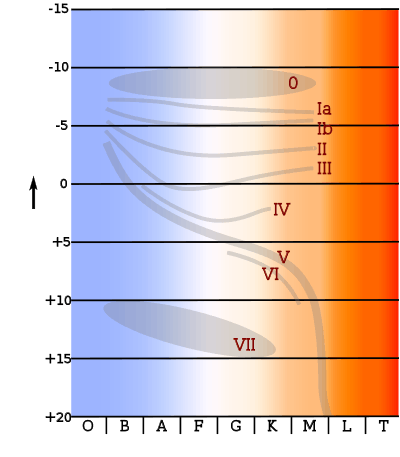Subdwarf

A subdwarf, sometimes denoted by "sd", is a star with luminosity class VI under the Yerkes spectral classification system. They are defined as stars with luminosity 1.5 to 2 magnitudes lower than that of main-sequence stars of the same spectral type. On an Hertzsprung–Russell diagram subdwarfs appear to lie below the main sequence.
The term "subdwarf" was coined by Gerard Kuiper in 1939, to refer to a series of stars with anomalous spectra that were previously labeled as "intermediate white dwarfs".[1]
Cool subdwarfs
Like ordinary main-sequence stars, cool subdwarfs (of spectral types G to M) produce their energy from hydrogen fusion. The explanation of their underluminosity lies in their low metallicity: these stars are unenriched in elements heavier than helium. The lower metallicity decreases the opacity of their outer layers and decreases the radiation pressure, resulting in a smaller, hotter star for a given mass.[2] This lower opacity also allows them to emit a higher percentage of ultraviolet light for the same spectral type relative to a Population I star, a feature known as the ultraviolet excess.[3] Usually members of the Milky Way's halo, they frequently have high space velocities relative to the Sun.
Subclasses of cool subdwarfs are as following:[4]
- cool subdwarf: Example: SSSPM J1930-4311 (sdM7)
- extreme subdwarf: Example: APMPM J0559-2903 (esdM7)[5]
Hot subdwarfs
Hot subdwarfs, of spectral types O and B, also termed "extreme horizontal branch stars" are an entirely different class of objects to cool subdwarfs. These stars represent a late stage in the evolution of some stars, caused when a red giant star loses its outer hydrogen layers before the core begins to fuse helium. The reasons why this premature mass loss occurs are unclear, but the interaction of stars in a binary star system is thought to be one of the main mechanisms. Single subdwarfs may be the result of a merger of two white dwarf stars. Subdwarf B stars, being more luminous than white dwarfs, are a significant component in the hot star population of old stellar systems, such as globular clusters and elliptical galaxies.[6]
Notable subdwarfs
- Kapteyn's Star
- Groombridge 1830
- Mu Cassiopeiae
- 2MASS J05325346+8246465, a possible halo brown dwarf and the first substellar subdwarf.[7]
- SSSPM J1549-3544
References
- ↑ Ken Croswell, The Alchemy of the Heavens, (New York: Oxford UP, 1995), p. 87.
- ↑ James Kaler, Stars and their Spectra, (Cambridge: Cambridge UP, 1989), p. 122.
- ↑ Ken Croswell, The Alchemy of the Heavens, (New York: Oxford UP, 1995), pp. 87–92.
- ↑ Discovery of the Coolest Extreme Subdwarf, Burgasser, Adam J. & Kirkpatrick, J. Davy, 2006.
- ↑ APMPM J0559-2903: The coolest extreme subdwarf known
- ↑ Jeffery, C. S. (2005). "Pulsations in Subdwarf B Stars". Journal of Astrophysics and Astronomy 26 (2–3): 261. Bibcode:2005JApA...26..261J. doi:10.1007/BF02702334.
- ↑ The First Substellar Subdwarf? Discovery of a Metal-Poor L Dwarf with Halo Kinematics, Adam J. Burgasser, et al. 2003
| ||||||||||||||||||||||||||||||||||||||||||||